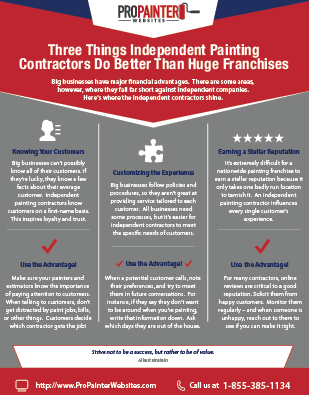Comprehending Seasonal Influences On Commercial Outside Painting: Vital Knowledge For Success
Comprehending Seasonal Influences On Commercial Outside Painting: Vital Knowledge For Success
Blog Article
Staff Author-Ford Urquhart
When you're preparing a commercial exterior paint project, seasonal factors can make or break your outcomes. You'll wish to think about just how temperature level and humidity effect paint application and drying times. Picking the ideal period can guarantee your paint adheres effectively and lasts much longer. Yet which seasons are really the most effective for this sort of job? Let's discover the crucial elements that can influence your project's success.
The Effect of Temperature on Paint Application
When you're planning a commercial external paint job, the temperature can significantly influence just how well the paint sticks and dries.
Preferably, residential painter tulsa intend to repaint when temperature levels range between 50 ° F and 85 ° F. If it's as well chilly, the paint may not heal properly, leading to concerns like peeling or fracturing.
On the flip side, if it's too warm, the paint can dry out too rapidly, protecting against correct adhesion and leading to an uneven finish.
You need to also consider the time of day; morning or late afternoon provides cooler temperature levels, which can be more positive.
Constantly check the manufacturer's suggestions for the details paint you're using, as they usually offer guidance on the suitable temperature variety for optimum results.
Humidity and Its Impact on Drying Times
Temperature isn't the only ecological variable that influences your commercial outside paint project; moisture plays a considerable role too. High moisture levels can slow down drying out times significantly, affecting the general high quality of your paint task.
When the air is filled with moisture, the paint takes longer to heal, which can cause problems like poor adhesion and a greater danger of mildew development. If you're painting on an especially humid day, be gotten ready for extended delay times in between layers.
It's crucial to check neighborhood weather conditions and plan accordingly. Preferably, look at these guys for moisture levels in between 40% and 70% for optimal drying.
Keeping these factors in mind ensures your task stays on track and supplies a lasting coating.
Best Seasons for Commercial Outside Painting Projects
What's the very best season for your commercial outside paint jobs?
Springtime and early fall are generally your best bets. Throughout these periods, temperature levels are light, and humidity degrees are often lower, producing optimal conditions for paint application and drying.
Avoid summertime's intense heat, which can cause paint to completely dry also rapidly, resulting in poor attachment and surface. Similarly, winter's cool temperature levels can prevent appropriate drying and healing, running the risk of the longevity of your paint task.
Aim for days with temperature levels between 50 ° F and 85 ° F for ideal outcomes. Remember to check the local weather prediction for rainfall, as damp conditions can spoil your task.
Planning around these factors ensures your paint job runs efficiently and lasts much longer.
Final thought
To conclude, intending your commercial external paint tasks around seasonal considerations can make a significant difference in the outcome. By organizing work during the optimal temperature levels and moisture levels, you'll make certain much better attachment and drying out times. Remember to keep an eye on regional weather prediction and select the correct time of year-- springtime and very early loss are your best choices. Taking these steps will certainly aid you achieve a long lasting and professional coating that lasts.
